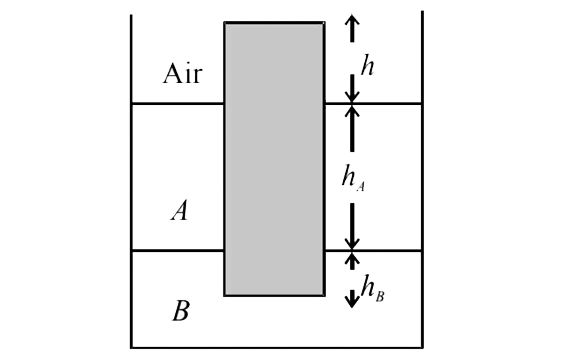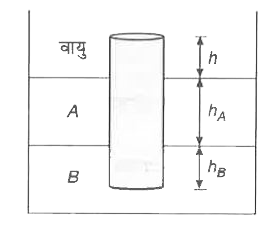A uniform solid cylinder of density 0.8g/cm3 floats in equilibrium in a combination of two non-mixing liquids A and B with its axis vertical.
The densities of the liquids A and B are 0.7g/cm3 and 1.2g/cm3, respectively. The height of liquid A is hA=1.2cm. The length of the part of the cylinder immersed in liquid B is hB=0.8cm.

(a) Find the total force exerted by liquid A on the cylinder.
(b) Find h, the length of the part of the cylinder in air.
Solution in Gujrati
The correct Answer is:(i). Zero
(ii). 0.25 m
(iii). g6
Step by step video & image solution for A uniform solid cylinder of density 0.8g//cm^3 floats in equilibrium in a combination of two non-mixing liquids A and B with its axis vertical. The densities of the liquids A and B are 0.7g//cm^3 and 1.2g//cm^3, respectively. The height of liquid A is h_A=1.2cm. The length of the part of the cylinder immersed in liquid B is h_B=0.8cm. (a) Find the total force exerted by liquid A on the cylinder. (b) Find h, the length of the part of the cylinder in air. by Physics experts to help you in doubts & scoring excellent marks in Class 11 exams.
Updated on:21/07/2023Topper's Solved these Questions
- ELASTICITY, SURFACE TENSION AND FLUID MECHANICSBOOK - ALLEN CHAPTER - ELASTICITY, SURFACE TENSION AND FLUID MECHANICSEXERCISE - Exercise 5 B (Integer Type Questions)
3 Videos
- ELASTICITY, SURFACE TENSION AND FLUID MECHANICSBOOK - ALLEN CHAPTER - ELASTICITY, SURFACE TENSION AND FLUID MECHANICSEXERCISE - Exercise 5 B (Assertion Reason)
1 Videos
- CENTRE OF MASSBOOK - ALLEN CHAPTER - CENTRE OF MASSEXERCISE - EXERCISE-V B
19 Videos
- ERROR AND MEASUREMENTBOOK - ALLEN CHAPTER - ERROR AND MEASUREMENTEXERCISE - Part-2(Exercise-2)(B)
22 Videos
Similar Questions
Two soap bubbles A and B are kept in a closed chamber where the air is maintained at pressure 8N/m2.The radii of bubbles A and B are 2cm and 4cm, respectively. Surface tension of the soap-water used to make bubbles is 0.04N/m. Find tha ratio nB/nA, where nA and nB are the number of moles of air in bubbles A and B, respectively. [Neglect the effect of gravity.]
View SolutionSTATEMENT-1: The stream of water flowing at high speed from a garden hose pipe tends to spread like a fountain when held vertically up, but tends to narrow down when held vertically down.
STATEMENT-2: In any steady flow of an incompressible fluid, the volume flow rate of the fluid remains constant.
View SolutionTwo particles of masses m1 and m2 in projectile motion have velocities →v1 and →v2 , respectively , at time t=0. They collide at time t0. Their velocities become →v'1 and →v'2 at time 2t0 while still moving in air. The value of ∣∣∣(m1→v'1+m2→v'2)−(m1→v1+m2→v2)∣∣∣
View SolutionA cube has a side of length 1.2×10−2m. Calculate its volume.
View SolutionTwo non-mixing liquids of densities rho and (n gt1) are put in a container. The height of each liquid is h . A solid cylinder of length L and density d is put in this container. The cylinder floats with its axis vertical and length pL(p lt 1) in the denser liquid. The density d is equal to :
View SolutionTwo immiscible of densities 2.5g/cm3 and 0.8g/cm3 are taken in the ratio of their masses as 2:3 respectively find the average density of the liquid conbination.
View SolutionWhat volume of liquid A has the same mass as 80.0cm^(3) of liquid B? {:(,"Density" g//cm^(3)), ("Liquid A", 0.660), ("Liquid B", 1.59):}
View Solutiontwo cylinders A and B are of the same dimensions but of different materials. A alone flots in a liquid with half of its length immersed. When B is placed over A , the combination just floats in the same liquid . Compare the densities of the two cylinders A and B.
View SolutionA container is filled with two immiscible liquids A and B of densities "2 g cm"^(-3) and "3 g cm"^(-3) , respectively. A wooden cube of side 1 cm floats on the surface of liquid A such that one-fourth of its total length is immersed in this liquid (A). Now, the wooden cube is completely immersed in liquid A by suspending a sinker of volume "10 cm"^(3) which is completely submerged in liquid B. Determine the weight of the sinker.
View Solutionएक एकसमान ठोस बेलन, जिसका घनत्व 0.8 ग्राम/सेमी3 है, दो अमिश्रित द्र्वो A तथा B के संयोजन में संतुलन की अवस्था में ऊर्ध्वाधर तैरता है। द्र्वो A तथा B के घनत्व क्रमशः 0.7 ग्राम/सेमी3 तथा 1.2 ग्राम/सेमी3 है। द्रव A की ऊँचाई hA=1.2 सेमी है। द्रव B में डूबे बेलन के भाग की लम्बाई hB=0.8 सेमी है।

(a) द्रव A द्वारा बेलन पर आरोपित कुल बल ज्ञात कीजिए।
(b) वायु में बेलन के भाग की लम्बाई h ज्ञात कीजिए।
(c ) बेलन को इतना दबाकर छोड़ दिया जाता है कि इसका ऊपरी सिरा, द्रव A के ऊपरी पृष्ठ के ठीक नीचे हो। छोड़ने के ठीक बाद बेलन का त्वरण ज्ञात कीजिए।
View SolutionTwo non-mixing liquids of densities ρ and nρ(n>1) are put in a container. The height of each liquid is h. A solid cylinder of length L and density d is put in this container. The cylinder floats with its axis vertical and length pL(p<1) in the denser liquid. The density d is equal to
View SolutionA solid floats in liquid A with half its volume immersed and in liquid B with 23 of its volume immersed. The densities of the liquids A and B are in the ratio.
View Solution10g of a liquid of density 5g cm^(-3) is mixed with 12g of another miscible liquid of density 4g cm^(-3) . Find the density of mixture.
View SolutionTwo non -mixing liquids of densities ρ and np (n>1) are put in container . The height of each liquid is h.A solid cylinder of length L and density d is put in this container . The cylinder floats with its axis vertical and length PL(P<1) in the denser liquid .The density d is equal to .......
View SolutionTwo non-mixing liquids of densities ρ and n ρ(n>1) are put in a container. The height of each liquid is h. A solid cylinder of length L and density d is put in this container. The cylinder floats with its axis vertical and length PL (P<1) in the denser liquid. The density dis equal to
View SolutionTwo non-mixing liquids of densities ρ and n ρ(n>1) are put in a container. The height of each liquid is h. A solid cylinder of length L and density d is put in this container. The cylinder floats with its axis vertical and length PL (P<1) in the denser liquid. The density dis equal to
View Solution
